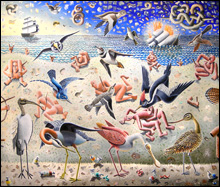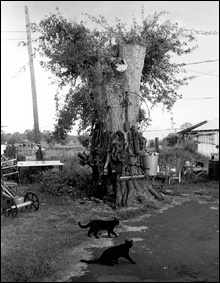
WHERE WE COME FROM: In Morgan Bulkeley’s work, Bosch meets Rousseau and Keith Haring meets Roger Tory Peterson.
|
One of the invigorating qualities of summer art shows in Boston is their relative playfulness. Nobody expects to attract the multitudes and dazzle the critics — at least not in the same way those expectations kick in for fall and spring. So relaxation trumps seriousness, risks almost outnumber sure bets, and expansiveness prevails over narrowly defined themes. Too bad our summers aren’t six months long.
The most challenging of this summer’s highlights turns up at Genovese/Sullivan Gallery, where Matt Harle’s casual, enigmatic, diffident sculptures remind us once again that the question Duchamp raised and Warhol explored — What makes art? — is alive and well and raging in the South End. Harle has enjoyed a reputation as one of Gen X’s outstanding minimalists, notably for his brightly colored cast rubber sculptures, long as anacondas and shaped like dental molding, that slither across gallery walls like architectural details fashioned from intestines. A similar fusion of the organic and the manufactured describes his current body of work, which looks like thin, industrial, 3-D versions of pressed leaves.
Harle combines care and casualness. The rubber moldings had the authority of temple friezes that could be washed away with a garden hose; his pressed-leaf sculptures look painstakingly exact and also like the work of an eight-year-old. Between two sheets of identically sized translucent white plastic — some shaped like triangles, others less geometrically precise — crude fans of wood and colored plastic resemble the veins of desiccated flora. There’s balance and bilateral symmetry; there’s also randomness and mischief. The sculptures are typically held together by a small length of industrial wire; one’s clipped shut by a green plastic clothespin. And the circumference of each sculpture is slightly open, as if it were a dying bivalve; you can peek into its interior. Fragile buildings suggestive of hands loosely clasped in prayer, Harle’s pieces are both maquettes and fully finished, the mature work of a young spirit dedicated to process as much as product.
At the other end of the spectrum (but only a few feet away) is the compelling group show of mostly black-and-white photographs of trees by 28 established and emerging artists at Gallery Kayafas. Close-ups and aerial views, leafy and leafless, festooned with human ornaments or smothered in magma, “Trees” is so rich in approaches, perspectives, moods, and sensibilities that a single visit will hardly allow you to see the forest. Plan on three. There are signature pieces by well-known artists: a brooding Harry Callahan image of three fledgling cypresses cornered in a courtyard like prisoners about to be shot; Aaron Siskind’s Corfu, 1971, which depicts the gnarled bark of a tree whose declivities conjure a haunting mask. Then there are the lesser-knowns. Frank Gohlke’s Aerial View of Cypress and Hardwood will make you do a double take: it looks like a close-up of the feathers on the back of a bird, a wavy carpet of densely packed peaks you feel you could stroke. Feathery in a different way is Boston-based photographer David Akiba’s Middle Tree, which rises up multi-armed like Vishnu from snow-covered ground against a background of half luminous fog, deliberate as a shrine, ephemeral as a candle.
ADVERTISEMENT
 |

MISSISSIPPI, 1993: Peter Kayafas’s tree trunk sprouts a disheveled coif of leaves, like the hair of a woman too burdened to care.
|
If Akiba’s ectomorphic trees belong to the æther, Peter Kayafas’s are squat mesomorphs with the bodies of peasants. Mississippi, 1993 depicts the cut-off trunk of a tree laden with working equipment — hoops and tools, pulleys and barrels — and it sprouts a disheveled coif of leaves, like the hair of a woman too burdened to care. The solitary figure of the wide triangular tree or bush in Kayafas’s In Romania appears silhouetted against the uneven white stucco of the nearby wall of a house. A single crude window chiseled into the cement echoes in its blackness the darkness of the bush, connecting the interior of the home with the manicured plant, as if it too belonged to the humble dwelling.
Judy Haberl’s Vase #2 takes the most radical and humorous look at a tree, in this case a twisting length called Harry Lauder’s walking stick. The tree itself resembles an amber cat-o’-nine-tails, with numerous droopy catkins that the artist has frozen into a form resembling a quart-sized milk bottle. There is, however, no exterior vessel, only milky ice in which we see the phallic, frigid forms of the plant. Part freezer-case find and part tundra excavation, Vase #2 evokes an imaginary world in which science plays slapstick.